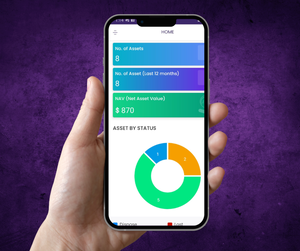Components of an Asset Tracking System
An asset tracking system typically consists of several components that work together to monitor and manage assets effectively. The key components include:
- Asset Tags or Labels - these are physical identifiers attached to assets, typically in the form of barcodes or RFID tags. They provide a unique identifier for each asset.
- Barcode Scanners or RFID Readers - these devices are used to capture asset tag information. Barcode scanners read barcode labels, while RFID readers use radio frequency identification technology to read RFID tags wirelessly. Smartphones can be used to read QR codes - a two-dimensional barcode - often used to track assets.
- Asset Management Software - this software provides a central platform to store and manage asset data. It allows users to track assets, view asset detail, generate reports, schedule maintenance, and perform other asset-related tasks. Metalcraft provides asset management software through our sister company, Grey Trunk RFID.
How does an asset tracking system utilize barcode or RFID technology?
As asset tracking system can utilize both barcode and RFID (Radio Frequency Identification) technologies to track and manage assets effectively. With both technologies, each asset is assigned a unique identifier. The unique identifier on a barcode asset tag is represented through a series of parallel lines of varying widths, along with numbers or alphanumeric characters. The barcode is scanned using a barcode scanner which converts the barcode into a digital format to be processed by the asset tracking system.
Each RFID asset tag has an RFID inlay which contains a small microchip and an antenna. An RFID reader emits radio waves that power the passive RFID tag and retrieve the data stored in the tag's memory. The reader then captures the unique identifier or data from the RFID tag and sends it to the asset tracking system.
Both technologies capture and store the data, associating it with relevant information such as the asset's location, status, maintenance history, and other details. The choice between barcode and RFID depends on factors such as the scale of the project, desired automation level, budget, and specific requirements of the organization.

What is the role of asset tags or labels in an asset tracking system?
Asset tags or labels play a crucial role in an asset tracking system. They are physical or digital identifiers that are affixed to or associated with individual assets. These tags contain unique information about the asset in the form of barcodes and/or RFID (Radio Frequency Identification) tag.
The primary purpose of asset tags or labels is to enable accurate and efficient tracking of assets through their lifecycle. Key roles of asset tags or labels include:
- Asset Identification
- Data Capture
- Inventory Management
- Asset Tracking and Visibility
- Maintenance and Service Tracking
- Loss Prevention and Security
How does asset management software contribute to an asset tracking system?
Asset management software is a critical component of an asset tracking system. It provides the necessary tools and features to effectively track and manage assets throughout their lifecycle. Here are some ways asset management software contributes to an asset tracking system:
- Centralized Asset Database - asset management software serves as a central repository for storing all asset-related information like asset description, specifications, serial numbers, locations, maintenance history, and ownership information.
- Asset Identification and Labeling - asset management software integrates with barcode and/or RFID technologies enabling efficient information and labeling of assets.
- Check-In/Check-Out Management - asset management software incorporates check-in/check-out functionality, allowing users to record asset movements and assignments.
- Maintenance and Service Management - asset management software can include features for managing maintenance schedules, service requests, and repairs.
Click here for more information on asset management software or to schedule a demo of our sister company's offering Grey Trunk RFID.
What are the benefits of integrating mobile devices or smartphones with an asset tracking system?
Integrating mobile devices or smartphones with an asset tracking system offers multiple benefits including:
- Real-Time Asset Visibility - utilizing mobile devices you can have real-time visibility into the location and status of your assets.
- Increased Mobility and Flexibility - mobile integration allows for asset tracking on the go. With smartphones or other mobile devices, you can track assets from anywhere, at any time.
- Improved Productivity and Reduced Cost - mobile integration simplifies the asset tracking process by eliminating the need for separate tracking devices or manual data entry. By leveraging smartphones, you can streamline workflows, automate tracking tasks, and reduce administrative overhead leading to increased productivity and cost saving.
For more information on asset tracking systems or to schedule a demo of Grey Trunk RFID asset management software click here. To learn more about asset tags, please contact us at [email protected].
 | About the Author: Marianne AlvaradoMarianne Alvarado is our Vice President of Sales. Alvarado joined Metalcraft in March of 2000 as a Territory Specialist, became Sales Manager in January 2022 and was named Vice President of Sales during August of 2023. She leads both the Outside and Inside Sales teams. Marianne lives in Davenport with her husband, Dave Beeman. Mobile Phone: 641-529-9492 Email: [email protected] Office: 3360 9th St. SW, Mason City, IA 50401 Office Phone: 641-423-9460 |




